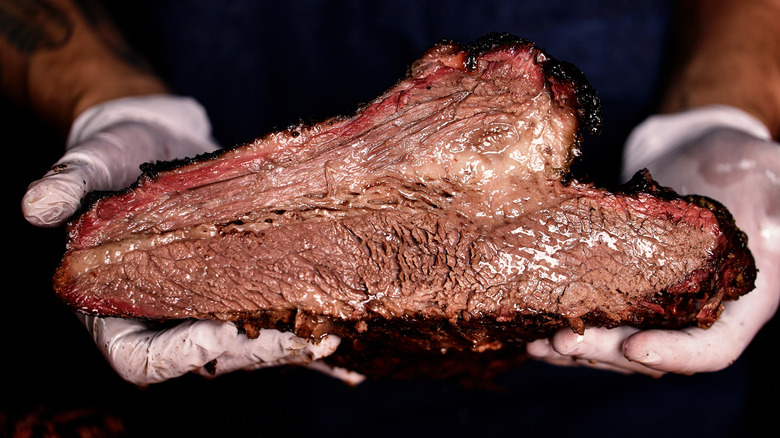The Differences You Need To Know Between A Brisket Flat And Point Cut
Barbecue may be the quintessential American food, and when it comes to smoking meat, brisket is the ultimate challenge. You might have a lot of questions about brisket — things like what are the benefits of smoking meat in butcher paper vs. tin foil, or even just how long should it take to smoke a brisket — and one of the chief ones might be what's the difference between a brisket flat and point cut?
As you can probably guess from the difference in terms, these aren't the same thing; they're actually two different muscles that comprise the cut we collectively know as "brisket." While there are times when you might find the two portions sold together in one solid piece, they're often separated, and each has their strengths and weaknesses. Typically, the rule is this: barbecue brisket (such as smoked brisket) comes from the point cut, while braised brisket (such as Jewish holiday brisket) comes from the flat.
The flat and point are different muscles, but they're both brisket
The two muscles that make up the brisket are located on the cow's chest, right above the front legs. This makes them well-worked muscles, which is why they both need slow cooking to break down their connective tissue. This is also the reason that brisket is the unexpected meat you need to avoid grilling at all costs. Typically, the flat is known as the "first cut," while the point is either called the "second cut" or the "deckle cut." That term is important, as "deckle" refers to the layer of hard fat and intercostal meat located between the two cuts, which is why they're separated (since that layer can be less than appetizing).
It's really not hard to spot which cut is which, either, as the flat is a big rectangle with even thickness and consistency throughout, while the point cut has a rounded point at one end (which explains its name), with the rest being more of an oblong, uneven shape. In addition, the flat is bigger; while the total weight of a full brisket is typically 10 to 16 pounds, most of that is the flat at around 6 to 10 pounds. The point, meanwhile, comes in at a lesser 5 to 6 pounds.
The two cuts are typically used differently
These physical distinctions help explain the different uses for the two cuts of meat. Because it's leaner, the flat cut is the version of brisket that's a staple dish to serve on Jewish holidays. The same is true of corned beef, where brisket is cured in a salt solution (in the U.S., corned beef is almost always brisket). The firmer structure of the leaner cut and the more uniform texture makes it perfect for these sliced preparations, as you can be sure that the slices will be generally even and consistent.
The additional fat and marbling of the point cut, meanwhile, makes it an ideal meat for barbecue. A smoked brisket usually comes from the point — though the use of the full brisket is what makes Texas brisket stand out from the rest — and it's the preferred cut for something like barbecue pulled beef. The additional fat makes it juicier and more tender, which are both prized qualities in barbecue.


